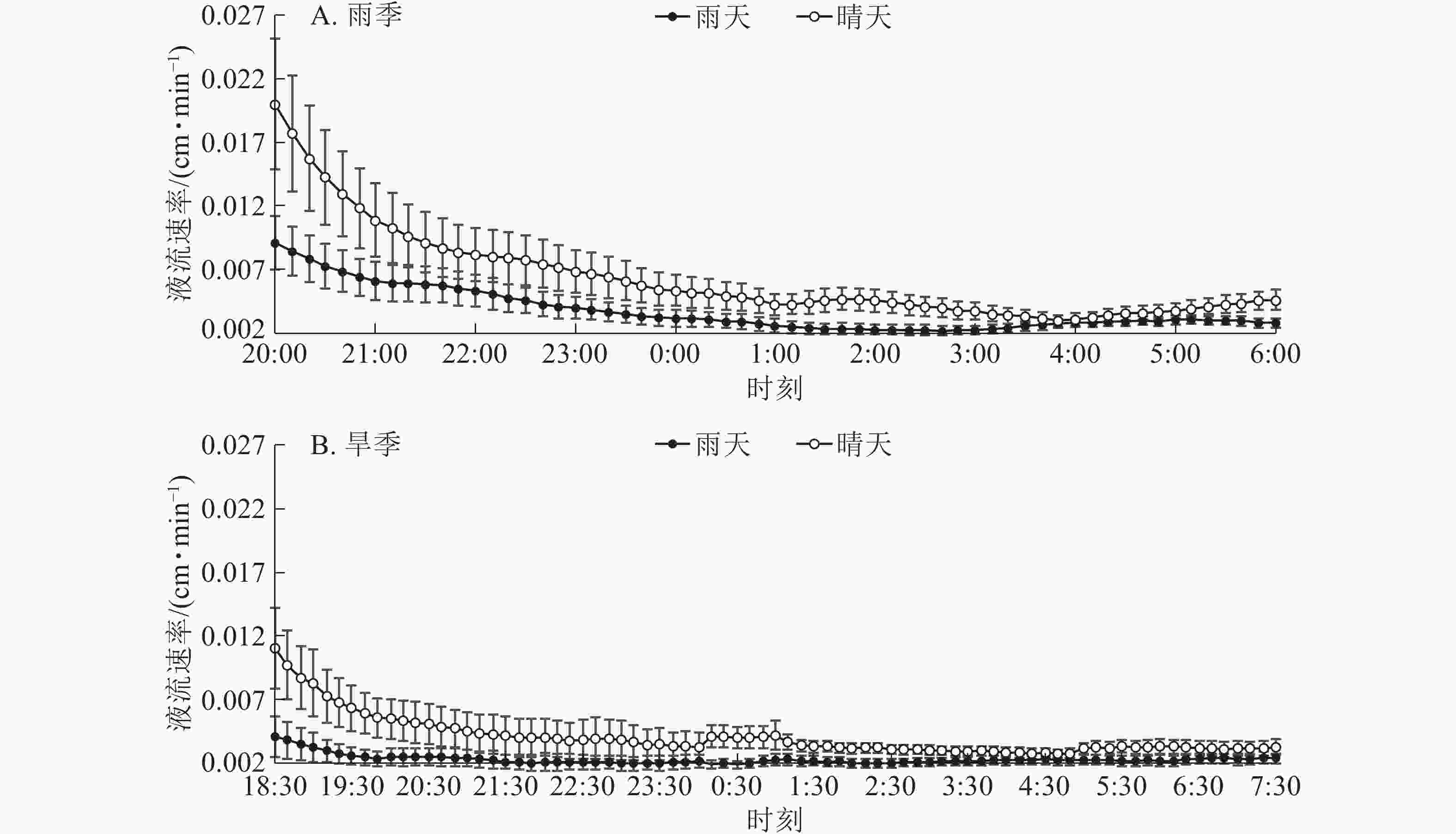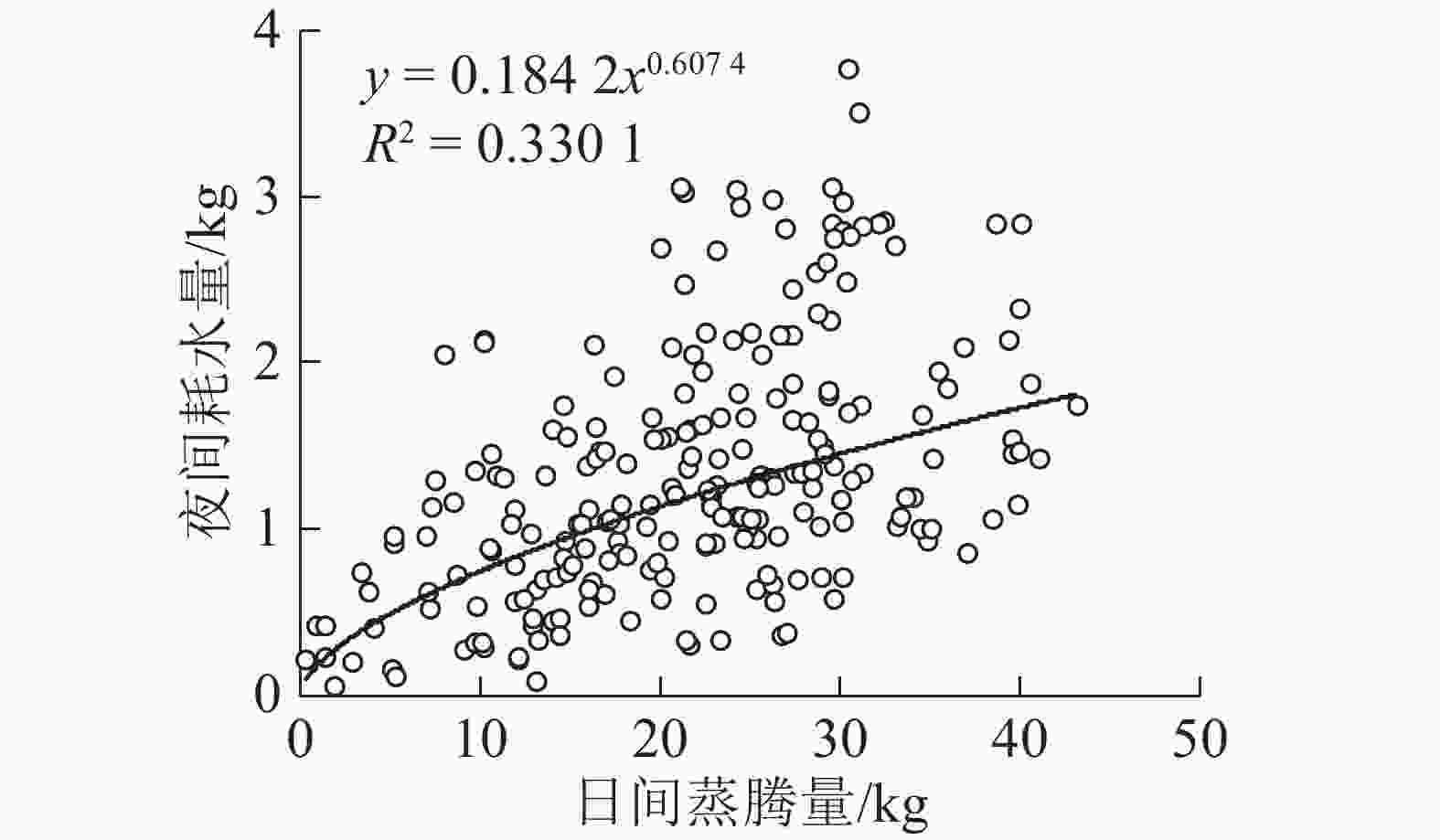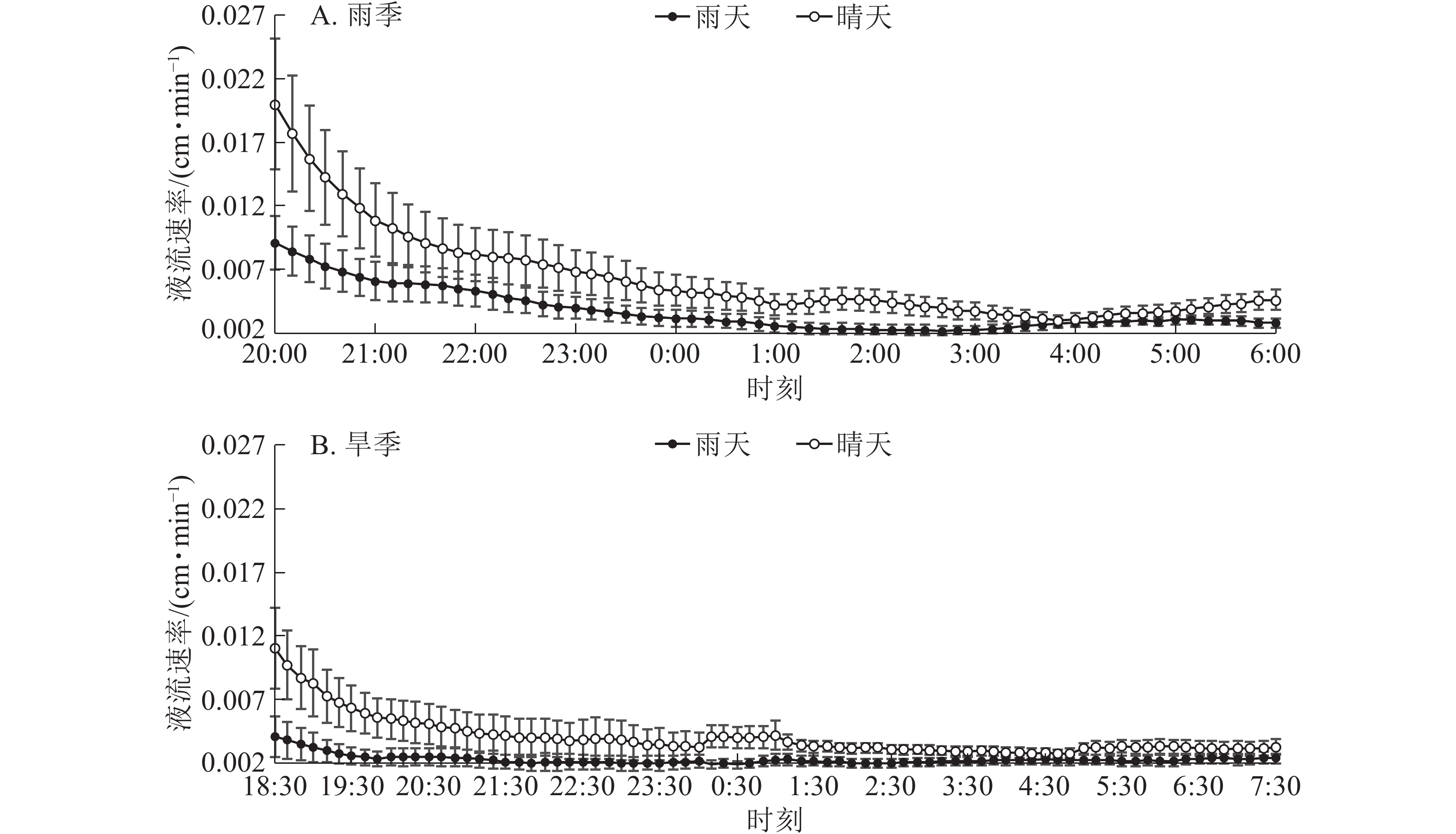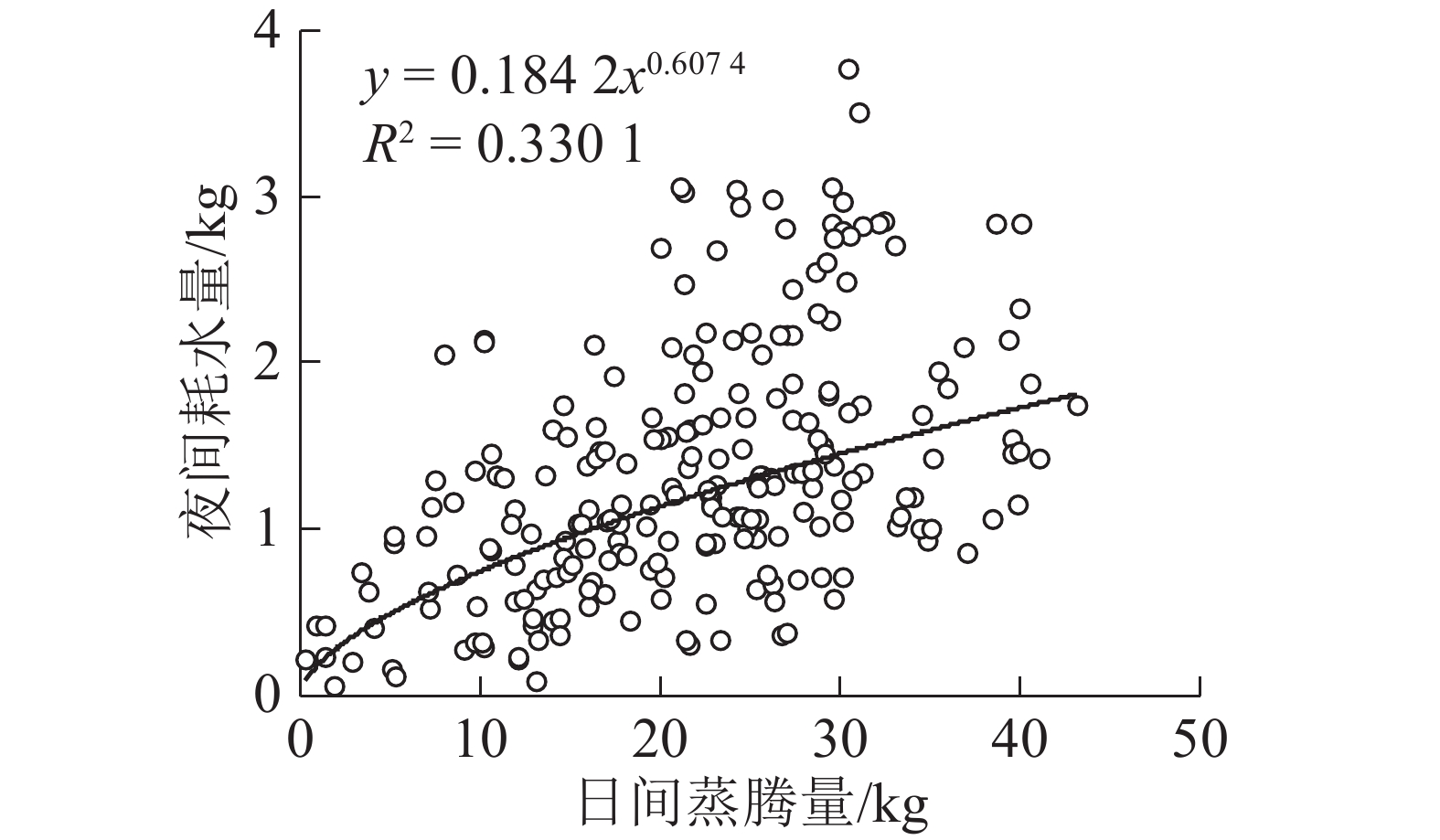-
植物树干液流是研究森林生态水文过程的一个重要方面,对于掌握植物需耗水规律及评价森林生态系统功能意义重大。长期以来,人们定量研究植物液流多集中在树木的日变化及季节变化上[1-2],而针对夜间液流的研究相对较少[3-4],几乎所有的植物均存在夜间液流现象[5]。夜间液流不仅可以补充因白天蒸腾造成的水分亏缺[6],有助于夜间的养分运输[7],还能为树木器官夜间呼吸提供氧传递机制[8],同时还对第2天光合作用、蒸腾作用及抗干旱胁迫具有重要的生理意义[9]。以往学者认为树木夜间液流所占比例较小[10-11],因此,在传统生态水文模型中,很多均忽略了夜间液流,甚至假设无夜间液流。随着研究的深入,发现不同树种间的夜间液流差异很大,甚至很多树种夜间液流通量占整日液流通量的比例还较高。陈立欣等[12]对大连4种绿化乔木夜间液流研究中得出:夜间液流总量占观测期液流总量的比例为0.44%~75.96%;赵春彦等[13]对胡杨Populus euphratica各月夜间累计液流量的研究发现:夜间液流占整日累计液流量的比例为26.2%~45.7%。由此可见,多尺度水量平衡估算模型若假设夜间无液流[14],将大大降低对林分耗水量的估算精度,进而影响人们对水资源的管理和决策,因此,对夜间液流进行准确的定量分析对于进一步提高林分耗水估算精确度具有重要意义。桉树Eucalyptus spp.是中国南方的重要战略树种,种植面积已达546.74 万hm2。由于其光合作用强、生长迅速,单位时间单位面积水分利用量高于一般树种,使得桉树的耗水问题一直成为广泛争论和关注的焦点[15-16]。为了更好地理解桉树人工林生态水文过程,需准确定量研究水量平衡中的所有组成部分,而目前对桉树夜间树干耗水特征的研究一直鲜有报道,且对其夜间耗水产生的驱动因素尚不明确。本研究利用精确度高、对植株损伤小、可在树木自然生长状态下对树干液流连续观测的Granier热扩散探针法(TDP)[17]对雷州半岛地区10年生尾叶桉E. urophylla夜间液流进行连续观测,并结合自动气象观测站对环境因子作同步测定,深入探讨尾叶桉树干夜间耗水特征及驱动因素,旨在提高大尺度尾叶桉林分耗水估算精确度,也为正确认识尾叶桉蒸腾及耗水规律提供数据支持。
-
样地设置在广东雷州半岛湛江桉树森林生态系统国家定位观测站内(21°30′N,111°38′E),海拔90 m,地势平坦。属海洋性季风气候,年平均降雨量约1 500.0 mm,多集中在5−10月的雨季,占全年降雨量的77%~85%,年平均气温23.0 ℃,年总辐射量4 240 MJ·m−2·a−1,年平均相平相对湿度80%。研究区土壤类型主要是玄武岩砖红壤,土层厚度2 m以上,0~80 cm土层内平均有机质16.0 g·kg−1以上,pH 4.5~5.3,土壤肥力属中等水平。乔木层主要有尾叶桉;林下植被丰富,主要灌木有野牡丹Melastoma candidum、马樱丹Lantana camara等;主要草本植物有飞扬草Euphorbia hirta、飞机草Eupatorium odoratum、蟛蜞菊Wedelia chinensis以及白花鬼针草Bidens alba等。
观测林地为10年生尾叶桉人工纯林,现存密度1 245株·hm−2,叶面积指数1.37,平均胸径为22.5 cm,平均树高为21.7 m,平均冠幅为3.61 m。在尾叶桉人工林林分调查的基础上,选择具有代表性的样地,样地面积为400 m2。在样地内,选择5株生长良好、无病虫害、树干圆满通直无挤压的标准木作为液流持续观测样树。样树的各项参数详见表1。观测时间2017年6月−2018年5月。
样树
编号林龄/
a胸径/
cm树高/
m冠幅(东西×
南北)/(m×m)边材面积/
cm21 10 21.7 21.2 2.80×3.45 205.8 2 10 25.5 23.7 3.35×3.33 284.3 3 10 22.2 24.5 4.60×3.20 215.4 4 10 25.1 20.3 3.90×3.65 275.4 5 10 20.8 18.8 3.55×3.90 189.1 Table 1. Basic conditions of the sample trees
-
树干液流测定方法采用Granier热扩散探针法,传感器采用德国Ecomatik公司SF-L4针型热扩散探针(4个探针分别为S0、S1、S2与S3,探针长33 mm),数据采集器采用DL2e数据采集器,采集频率为10 min 1次,与气象监测时间同步。为避免不同高度、不同方位间液流的差异以及太阳辐射的影响,探针均安装在同一高度(1.3 m)的北侧,同时用防辐射铝箔覆盖。液流计算公式:
式(1)和(2)中:Vs为液流速率(cm·min−1);dtmax、dtact均由式(2)计算得到,dtmax一般指夜间空气湿度为100%长达2 d或树干直径停止变化、处于相对稳定状态时算得的dt值;T1−0、T1−2、T1−3为探针S0、S2、S3分别与S1间的温度差(℃)。
-
在尾叶桉人工林试验区附近开阔地带安置有自动气象观测系统,装有Campbell公司CR 3000型数据采集器、HMP 155A空气温湿度传感器、TE 525MM雨量筒及LI 190SB型光合有效辐射传感器,连续观测试验期间的大气温度(T,℃)、空气相对湿度(HR,%)、降雨量(R,mm)及光合有效辐射(PPAR, μmol·s−1·m−2)等气象指标,数据采集时间间隔为10 min,与液流监测时间间隔一致。同时,为考虑大气温度和湿度的协同效应,利用大气温度和相对湿度计算空气饱和水汽压差(DVPD,kPa),公式如下:
式(3)中:HR为空气相对湿度(%);T为空气温度(℃)。
-
尾叶桉夜间耗水量是指在PPAR为0时由液流速率(取5株样树的平均值)计算而得的液流通量[18-19],夜间耗水贡献率是指桉树夜间液流通量占日总液流通量的比率。其计算公式为:
式(4)和(5)中:Q夜为夜间耗水量(kg);n为夜间的数据采集个数,
$v_{{\rm{s}}_i} $ 为夜间第i个10 min液流速率的平均值(cm·min−1);As为边材面积(cm2);t为监测时间间隔,大小为10 min。Q全天为日总液流通量(kg);r为夜间耗水贡献率(%)。 -
边材面积As是计算耗水量的重要参数,且无法在树木生长的情况下直接测量,只能通过生长锥测定胸径处的边材厚度(尾叶桉边心材颜色区分明显),然后量取胸径和树皮厚度,来计算边材面积。为避免生长锥对样树液流产生影响,在样地外选取30株不同胸径的树木进行测定,建立胸径和边材面积关系方程:As=0.438 2
$D^2_{\rm{BH}} $ −2.701 4DBH+18.489 0,其中DBH为胸径,R2=0.81,拟合效果较好,并以此关系式计算5株样树的边材面积(表1)。 -
采用Excel 2016制表并作图,利用SPSS 19.0统计软件对所有数据进行统计分析。胸径与边材面积关系方程采用曲线估计法;各月日平均液流速率、夜间耗水量及耗水贡献率年内变化采用单因素方差分析及Duncan分析;夜间液流速率、耗水量与主要影响因子的关系分析采用相关分析及回归分析。
-
分别选取旱季(12月)与雨季(7月)典型月份的夜间液流速率进行分析并作图(图1)。由图1可知:无论旱季还是雨季,夜间液流速率均是前半夜液流速率高,变化幅度大,而后半夜较小且相对比较稳定。尾叶桉夜间液流旱季与雨季存在较大差异,由于夏季昼长夜短,而研究区雨季与夏季同期,根据自动气象观测站光合有效辐射数据可以得出:雨季夜间液流启动时间(20:00)要比旱季晚约1.5 h,而结束时间(6:30)要早于旱季1.0 h;夜间平均液流速率雨季(0.005 0 cm·min−1)显著大于旱季(0.004 3 cm·min−1,P<0.05),且前半夜的夜间液流速率雨季(0.007 3 cm·min−1)极显著大于旱季(0.005 4 cm·min−1,P<0.01),后半夜平均液流速率旱雨季间差异不显著(P>0.05)。可见夜间耗水主要发生于前半夜。
-
分别选取雨季典型雨天7月3日(降雨量11.0 mm)、13日(降雨量40.0 mm)、26日(降雨量16.0 mm)、29日(降雨量14.7 mm)和典型晴天7月12、15、16、24日的夜间平均液流速率及旱季典型雨天11月27日(降雨量7.9 mm)、28日(降雨量2.4 mm)、29日(降雨量0.3 mm)、39日(降雨量0.6 mm)和典型晴天11月22、23、24、25日的夜间平均液流速率数据作图(图2)。由图2可知:无论旱季还是雨季,晴天夜间液流变化幅度均显著大于雨天,夜间平均液流速率晴天(雨季0.006 3 cm·min−1、旱季0.004 1 cm·min−1)均极显著大于对应雨天(雨季0.003 8 cm·min−1、旱季0.002 3 cm·min−1)(P<0.01)。这可能是由于晴天白天的蒸腾作用强,引起的树干水分缺失大于雨天,根压较大,为保持体内水分平衡,水分以主动方式吸收进入树干,导致夜间液流速率及液流通量均大于雨天[19]。
-
通过对监测期间的夜间耗水贡献率的统计发现(图3):各月平均夜间耗水贡献率为3.5%~9.5%,总平均夜间贡献率为6.62%,其中旱季(11−4月)的夜间耗水贡献率为7.32%,是雨季月份(5.41%)的1.4倍。监测期间夜间耗水贡献率最大值出现在12月(46.2%),最小值出现在8月(0.61%)。由此可见,尾叶桉夜间也存在可观的耗水量,因此,对于大尺度尾叶桉人工林生态系统耗水量的估算,要充分考虑夜间的耗水。这将对于提高桉树林分耗水量估算模型的精确度意义重大。
-
气象因子一直是影响树木冠层蒸腾耗水的主要影响因子。那么夜间在没有光照等条件下,树木的耗水速率是否受气象因子的影响?通过Person相关分析可以看出(表2):雨季尾叶桉夜间液流速率与夜间气温和夜间饱和水汽压差均呈极显著正相关(P<0.01),相关系数分别为0.26和0.59,而与夜间空气相对湿度呈极显著负相关(P<0.01),相关系数为−0.54;旱季夜间液流速率与夜间饱和水汽压差和夜间风速呈极显著正相关(P<0.01),相关系数分别为0.61和0.17,而与夜间空气相对湿度呈极显著负相关(P<0.01),与夜间温度呈显著负相关(P<0.05),相关系数分别为0.60和0.06。可见尾叶桉夜间液流速率受夜间气象因子的影响。
季节 夜间气温 夜间空气相对湿度 夜间风速 夜间饱和水汽压差 相关系数 P 相关系数 P 相关系数 P 相关系数 P 雨季 0.26** 0.000 −0.54** 0.000 −0.02 0.090 0.59** 0.000 旱季 −0.06* 0.017 −0.60** 0.000 0.17** 0.000 0.61** 0.000 说明:*表示在0.05水平(双侧)上显著相关;**表示在0.01水平(双侧)上显著相关 Table 2. Person correlation analysis of nighttime flow rate and nighttime meteorological factor
把尾叶桉夜间液流速率与气象因子通过逐步法进行回归分析,以5%和10%的可靠性作为因变量入选和剔除临界值,最终得出回归方程:V雨=7.82×10−4+2.135×10−2VVPD,决定系数R2为0.346,t检验结果为极显著相关;V旱=1.22×10−3+2.571×10−2 VVPD,决定系数R2为0.370;t检验结果为极显著相关。其中:V雨和V旱分别为雨季夜间液流速率和旱季夜间液流速率(cm·min−1);DVPD为夜间饱和水汽压差(kPa)。通过t检验,可以看出无论是旱季还是雨季,夜间液流速率与饱和水汽压差间的拟合方程均具有高度统计学意义。旱季和雨季的决定系数R2分别为0.37和0.35,说明饱和水汽压差等气象因子可以解释37%(旱季)和35%(雨季)的夜间液流速率的变化。
-
较大的日间蒸腾量往往会导致树干水分的缺失,夜间耗水是否与树干补水作用相关,一定程度上可以通过分析夜间耗水量与日间蒸腾量是否存在相关关系来确定。本研究通过Pearson相关分析发现:夜间耗水量与日间蒸腾量存在极显著的正相关关系,相关系数为0.497。同时通过曲线参数估计法,描述夜间耗水量与日间蒸腾量间的回归关系,调用曲线参数估计法(curve estimation)模块,生成11种模型(线性模型、对数曲线模型、指数曲线模型及幂函数曲线模型等),筛选解析量决定系数R2最高的模型回归。最终结果如图4所示。分析发现:夜间耗水量与日间蒸腾量间的幂函数关系拟合最好,关系方程为:y=0.184 2x0.607 4,决定系数R2为0.330 1,经t检验,达到极显著水平。
-
通过热扩散探针法探讨10年生尾叶桉夜间液流发现,尾叶桉旱季和雨季均存在明显的夜间液流现象,但较白天液流速率小,且前半夜液流速率及变化幅度均大于后半夜。这与周翠鸣等[18]对木荷Schima superba以及王华等[19]对马占相思Acacia mangium夜间液流的研究结果相似,但与赵春彦等[13]对胡杨夜间液流通量先降低后升高的的研究结果不同。这可能是不同地区土壤含水量的差异及树木本身的生物学特性差异造成的。夜间液流由于受太阳年际起落规律的影响,使得雨季夜间液流较旱季启动时间晚,结束时间早。典型晴天和雨天下的尾叶桉夜间液流差异较大,无论旱季还是雨季,晴天夜间平均液流速率及夜间耗水量均较雨天大。王艳兵等[20]在对华北落叶松Larix principis-rupprechti夜间液流的研究中认为:晴天白天较强的树冠蒸腾造成的树干水分亏缺较雨天大,从而造成夜间液流速率较强。魏潇等[21]对青海云杉Picea crassifolia夜间液流的研究中也发现,典型晴天的平均液流速率及变化幅度均显著大于阴天。但尹立河等[22]对旱柳Salix matsudana和小叶杨Populus simonii以及陈立欣等[12]对大连4种城市绿化乔木夜间液流研究中却有相反的结论。造成差异的原因可能是与树种的生物学特性有关。各月监测期间尾叶桉平均夜间耗水贡献率变化范围为3.5%~9.5%,可见将尾叶桉夜间液流视为0的水量平衡估算模型来模拟尾叶桉蒸腾耗水量,大大降低了对林分耗水量的估算,因此,本研究对尾叶桉夜间液流特征的定量研究对大尺度尾叶桉林分耗水量的准确估算意义重大。
夜间液流产生的驱动因素一直是众多学者比较关心的问题,不同树种产生夜间液流的驱动因素可能不同,无非是夜间蒸腾和(或)树干补水。王华田等[23]在对油松Pinus tabuliformis和侧柏Platycladus orientalis边材液流的研究中认为:由于夜间气孔关闭,且空气湿度提高、温度下降,叶片蒸腾完全停止,由TDP测出的夜间液流不可能是树干蒸腾;鱼腾飞等[24]对胡杨蒸腾耗水的研究中发现:胡杨夜间有明显的蒸腾作用,平均蒸腾速率为0.7 mmol·m−2·s−1;尹立河等[22]对旱柳和小叶杨夜间液流研究中认为:2个树种夜间液流产生是由气孔蒸腾和树干补水共同作用造成的。王华等[6]以及BENYON等[25]认为:通过分析夜间液流与夜间饱和水汽压差的关系来确定是否存在夜间蒸腾,若它们之间显著相关,说明其夜间气孔开放,存在夜间蒸腾且显著相关、决定系数很大,说明其夜间液流主要用于夜间蒸腾,如北美红杉Sequoia sempervirens[26]和美国黄松Pinus ponderosa[10]决定系数分别为0.84和0.71;但若显著相关且决定系数较小,如巨桉Eucalyptus grandis[25]决定系数为0.37,说明其夜间液流除了夜间蒸腾还存在夜间补水;若两者无相关性,说明夜间液流主要用来树干补水。本研究对尾叶桉夜间补水影响因素研究中发现:尾叶桉无论是旱季还是雨季其夜间液流速率均与夜间饱和水汽压差呈极显著正相关,回归方程达到极显著水平,决定系数旱季为0.370,雨季为0.346。以上研究结果说明:尾叶桉夜间存在气孔蒸腾,但却只能解释34.6%~37.0%的夜间液流的变化。通过分析发现:尾叶桉夜间液流速率除了与夜间饱和水汽压差极显著正相关外,夜间耗水量还与日间蒸腾耗水量存在极显著正相关,且存在具有高度统计学意义的幂函数关系,且决定系数为0.33,可见日间蒸腾量也可以解释33%左右的夜间耗水。因此,推测尾叶桉夜间液流的驱动因素除了夜间蒸腾外,还有树干补水的作用。那么当2种因素同时存在时,具体哪一种对其影响比例较大,尚有争论。部分学者认为夜间蒸腾发生在前半夜,夜间补水发生在后半夜[12],而胡兴波等[27]认为,夜间补水主要发生在前半夜,蒸腾主要发生在后半夜。
本研究仅利用树干液流方法,难以确定夜间蒸腾和树干补水所占的比例,下一步需从生理层次对夜间的气孔导度及夜间蒸腾强度进行监测,更加深入了解尾叶桉夜间液流产生的原因及其所占比例,为精确估算林分耗水提供数据支持。
Characteristics and driving factors of nocturnal water consumption of Eucalyptus urophylla plantations in Leizhou Peninsula
doi: 10.11833/j.issn.2095-0756.20190531
- Received Date: 2019-09-09
- Rev Recd Date: 2020-02-21
- Available Online: 2020-07-21
- Publish Date: 2020-07-21
-
Key words:
- forest ecology /
- Eucalyptus urophylla /
- nocturnal sap flow /
- nocturnal water consumption /
- driving factor /
- nocturnal transpiration /
- trunk hydration
Abstract:
| Citation: | WANG Zhichao, XU Yuxing, ZHU Wankuan, et al. Characteristics and driving factors of nocturnal water consumption of Eucalyptus urophylla plantations in Leizhou Peninsula[J]. Journal of Zhejiang A&F University, 2020, 37(4): 646-653. DOI: 10.11833/j.issn.2095-0756.20190531 |
















 DownLoad:
DownLoad:


